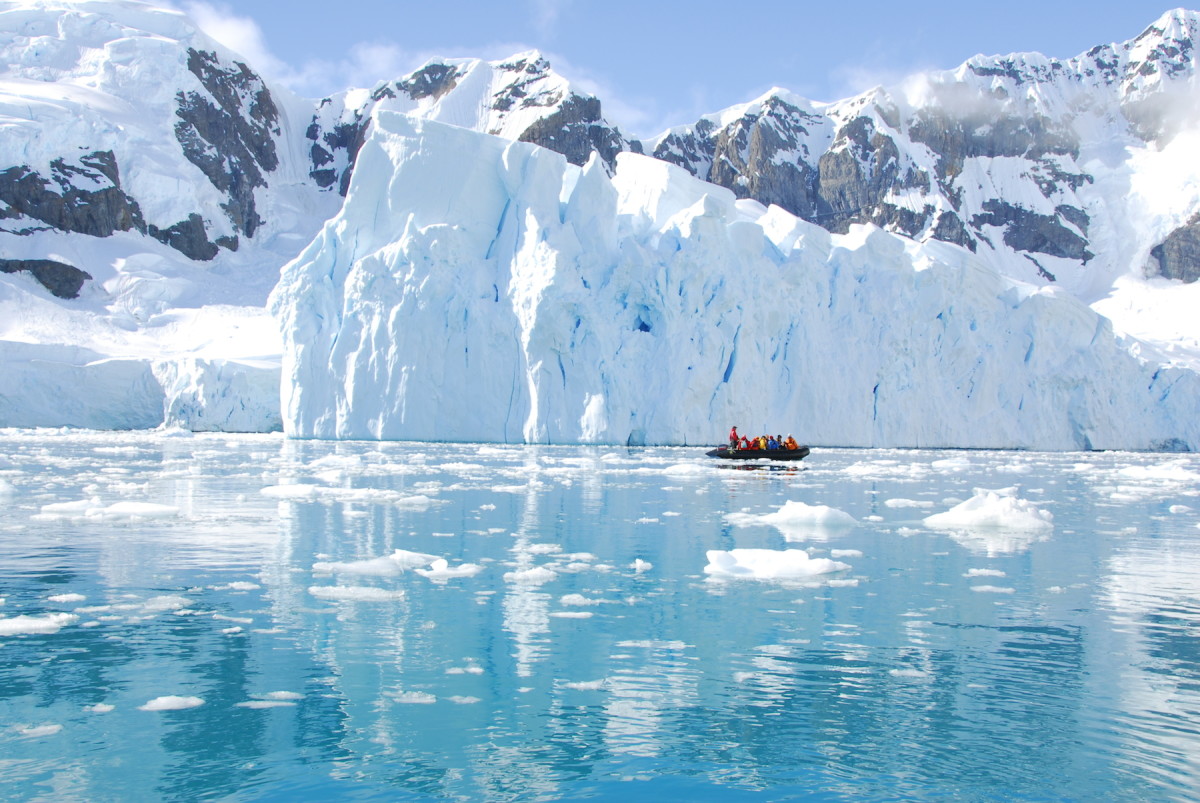For Alex Simpson, there’s something inherently wrong with luxury cruise ships, equipped with spas, gourmet dining halls, and workout rooms, sailing into polar landscapes immortalized by hard-ass explorers like Shackleton, Amundsen and Scott. There’s also something horribly hypocritical about hundreds of people, paying tens of thousands of dollars, traveling aboard a greenhouse gas-spewing vessel to the ends-of-Earth ecosystems most critically imperiled by climate change. Yet Simpson also recognizes the irony of his discontent. As he drifts between a bachelor’s degree and grad school, the sea kayak guide is happy to pocket the “greasy money” to be made in the booming expedition cruising trade.
“Antarctica is amazing. You can’t deny that,” Simpson says. “The scenery is jaw-dropping and we have encounters with wildlife that has no fear of humans at all.”
Simpson (not his real name) works aboard a luxury “expedition” ocean liner. By day, he guides the more adventurous guests on two-hour outings by tandem kayak, floating amongst icebergs and penguins. By night, he dons formal attire and hobnobs with “the one percent” — including bucket-listers, oil industry executives, and climate change deniers.
Reading an essay by novelist Jonathan Franzen, who participated on a National Geographic-sponsored cruise with Lindblad Expeditions, stoked Simpson’s cynicism. Franzen spent three weeks in the Southern Ocean, visiting South Georgia and the Falkland islands. An ardent bird-watcher and “accidental luxury tourist,” Franzen found himself outcast amongst a group of photography enthusiasts—“merely physicians and attorneys”—with cultish tendencies. Like Simpson, Franzen marveled at the stark landscape and rich biodiversity. But the experience left him jaded, a bitterness exemplified by the last day on the journey, when only half the participants attended a presentation on climate change. Franzen, meanwhile, couldn’t escape the fact that he was “sitting in the lounge of a ship burning 3.5 gallons of fuel per minute.”
Indeed, the most efficient cruise ships emit three to four times more carbon dioxide per passenger mile than a jet, according to a report in the New York Times. Just as big a problem for Simpson is the notion that human beings simply don’t belong in Antarctica. “Before the 1800s no human had set foot on the continent,” he says. “Now, with these ships, it’s becoming almost a right if you’re wealthy. This is the purest wilderness remaining on the planet. The environment doesn’t cater to humans at all.”
Simpson compares expedition cruising to the infamous commercialization of mountaineering in the Himalayas. “I see a lot of parallels with Everest,” he says. “Once, it was only for people like Hillary who were committed and had trained for years. Then, in the ‘90s, it became something that if you’re willing to pay enough, someone will carry you up the mountain. In a sense Antarctica is getting to that point. Pay the money, get on a ship and you’re there. Skills and self-reliance are replaced by gold-plated cruise ships.”

Comprehensive regulations have strictly controlled access and maintained a semblance of wilderness in Antarctica, Simpson admits. He clings to the fact that his kayak guests tend to be more engaged and compassionate—more open to the transformative power of spending time in wondrous places.
It’s this attitude that keeps veteran guides like Jeni Stembridge, a Portland, Ore.-based naturalist with close to a decade of experience in Antarctica, feeling like they’re part of a solution, not a problem. “I am optimistic that having these experiences will help bring environmental issues to the forefront of guests’ minds,” she says. “Just by sheer numbers, there is bound to be someone onboard, someday, who is so blown away by these places, whose life has been impacted by these experiences, and who has the resources back home to do something. [But] I battle with it internally all the time.”
Meantime, the expedition cruise industry is booming. The sector forecast to add 8,500 berths by 2023, “easily doubling 2018 capacity.” Among the new entries is Scenic Eclipse, an ultra-luxury line with destinations around the world, including the high arctic and Southern Ocean. Scenic Eclipse guests choose between kayak tours or excursions by helicopter or submarine. The trend is sure to continue as polar sea ice melts, exposing new areas like the Northwest Passage to tourists.
For David Newland, an ambassador and guide with Adventure Canada, a small operator with three decades of experience in the Arctic, the solution is to deliver more ethical tour options. “Concerned people need to ask,” Newland says, “‘Is there a way forward, culturally and economically for the Inuit and other coastal dwellers, that respects their heritage, language and culture, allows them to maintain presence in their homelands, and doesn’t depend on total degradation of the environment by way of resource extraction?’”
Adventure Canada focuses on “regenerative tourism,” offering its guests more intimate experiences by engaging local residents and ensuring that more economic benefits remain in remote Arctic communities. “Connecting people to place and the sense of community within a place and its culture is the center of our values,” explains Newland. “There’s no mistaking the carbon footprint. But we believe the value we bring is important and we’re not willing to simply abandon the space.
“If people don’t come with us it doesn’t mean they stay at home. They go somewhere else and do something else,” Newland insists. “By staying in the game we give a superior alternative. We can’t pull out of the Arctic, Newfoundland and Labrador because we feel like we’re part of a positive change.”
Each time he launches his boat, though he realizes it’s not the same as a true kayak-based expedition in wild lands, Simpson still smiles at his good fortune — no matter how much the employment tortures his conscience. “You’re kayaking in Antarctica,” he says. “How else would I get this opportunity?”
from Men's Journal https://ift.tt/2FIYn5d
No comments:
Post a Comment